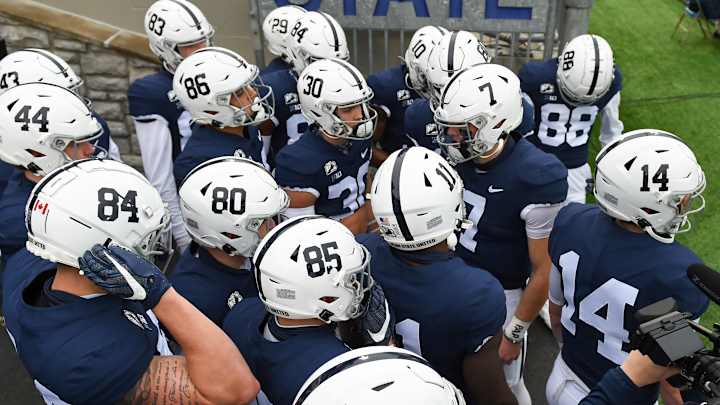Penn State and the Eight-Year Itch

In 2004, Penn State faced a crisis of offense. In 2012, Penn State faced a crisis of existence. In 2020, Penn State faces a crisis of confidence.
Those previous teams rose from their crises, girded by player leadership, to accomplish the unthinkable. In 2005, the Lions won the Big Ten title. In 2012, they won eight games.
So how does the 2020 team respond? That's the base question of this installment of Penn State and the eight-year itch.
The 2020 Lions, notoriously off to the program's first 0-5 start in history, have played very much like a winless team. In fact, Penn State is one of just three winless teams in the Power 5 (with Kansas and Vanderbilt) among those that have played at least five games.
Blocking, tackling and quarterback play are the foundation of football's periodic table of elements. Penn State isn't very good at any of them.
Further, the 2020 Lions have lost four of their key players (Micah Parsons, Journey Brown, Noah Cain and Pat Freiermuth), asked four new coaches to introduce themselves primarily via video, have turned over the ball 13 times (all by their quarterbacks) and have seen their head coach get in his own way.
During Saturday's 41-21 loss to Iowa, James Franklin went for two fourth-down attempts in the first half trying 'to inject some momentum in the offense" but elected to punt on a fourth-and-long down two touchdowns late in the game. Ultimately it didn't matter, but maybe the message did.
Penn State looks reluctant, exasperated and defeated. That's new for these players who, as Franklin said, have won 41 games over the past four years.
The program has been here before and plowed itself out under different staffs and circumstances. The common denominator of those situations, though, is a core group of players that willed Penn State off the ledge.
The 2004 Lions swam in the wake of a historically bad stretch known as the Dark Years that included four losing records in five seasons. That team was defeated offensively, scoring 10 or fewer points six times, but had the elements of a blossoming defense.
After the defense delivered a goal-line stand against Indiana, preserving a 22-18 win to end a six-game losing streak, then-assistant coach Jay Paterno said, "We may not lose again until 2006."
He was almost right. Penn State won its finale, then went 11-1 in 2005, claiming the Big Ten title and an Orange Bowl victory over Florida State. At the center of that team was a group of upperclassmen that had had enough.
Players like Michel Robinson, Tamba Hali, Matt Rice, Paul Posluszny, Alan Zemaitis and Jay Alford took control of their locker room and wouldn't let it crumble. Joe Paterno brought in some skill-position recruits for Robinson, who finished fifth in the Heisman Trophy voting, and the roster stuck together.
Eight years later, Bill O'Brien began his first training camp at Penn State in worse straits, simply trying to retain his roster. The NCAA sanctions following the Jerry Sandusky scandal offered players a chance to transfer for free, and some took advantage.
Without a collection of upperclassmen devoted to the program and each other, Penn State's roster would have withered. On July 25, 2012, Michael Mauti, Michael Zordich and a group of players stood outside the football building and said, "This program was not built by one man, and this program sure as hell is not going to get torn down by one man."
O'Brien's team had Mauti, Zordich, Jordan Hill, Matt McGloin, John Urschel, Stephon Morris, Gerald Hodges and more to guide it. The Lions went 8-4, after losing their first two games, and set the course for James Franklin's Big Ten title season four years later.
"We've had to learn how to handle success," Franklin said Saturday night at Beaver Stadium, "and now we're having to learn how to handle adversity."
The 2004 and 2012 seasons were inflection points for Penn State, from which the program ultimately progressed. The 2020 season is another. Perhaps it will be an outlier, a virus-burdened mess that lives as a mulligan in Penn State history.
There's a chance this season bleeds into the next, though. Penn State might face some continued limitations regarding spring practice. And the 2021 schedule is top-heavy, with games against Wisconsin, Auburn and Iowa in the first five weeks.
The roster also could get a broad sweeping. The NCAA in January is expected to pass a proposal allowing Division I athletes to transfer one time without penalty. That, coupled with the free season of eligibility, will open a fertile free-agent market.
How many players might leave? That's a fair question. Some turnover will be beneficial, but there's a limit. Penn State will struggle to withstand an large exodus.
So who keeps the roster together, engaged and looking ahead? Who are this team's Michael Robinson and Mike Mauti? Who says, "We've had enough"?
As in 2004 and 2012, the 2020 Penn State team is confronting a moment of stress. The coaches, Franklin chief among them, face a turning point. They'll need a committed core of players to help guide them through it.
Get the latest Penn State news by joining the community. Click "Follow" at the top right of our AllPennState page. Mobile users click the notification bell. And please follow AllPennState on Twitter @MarkWogenrich.

Mark Wogenrich is the editor and publisher of Penn State on SI, the site for Nittany Lions sports on the Sports Illustrated network. He has covered Penn State sports for more than two decades across three coaching staffs, three Rose Bowls and one College Football Playoff appearance.